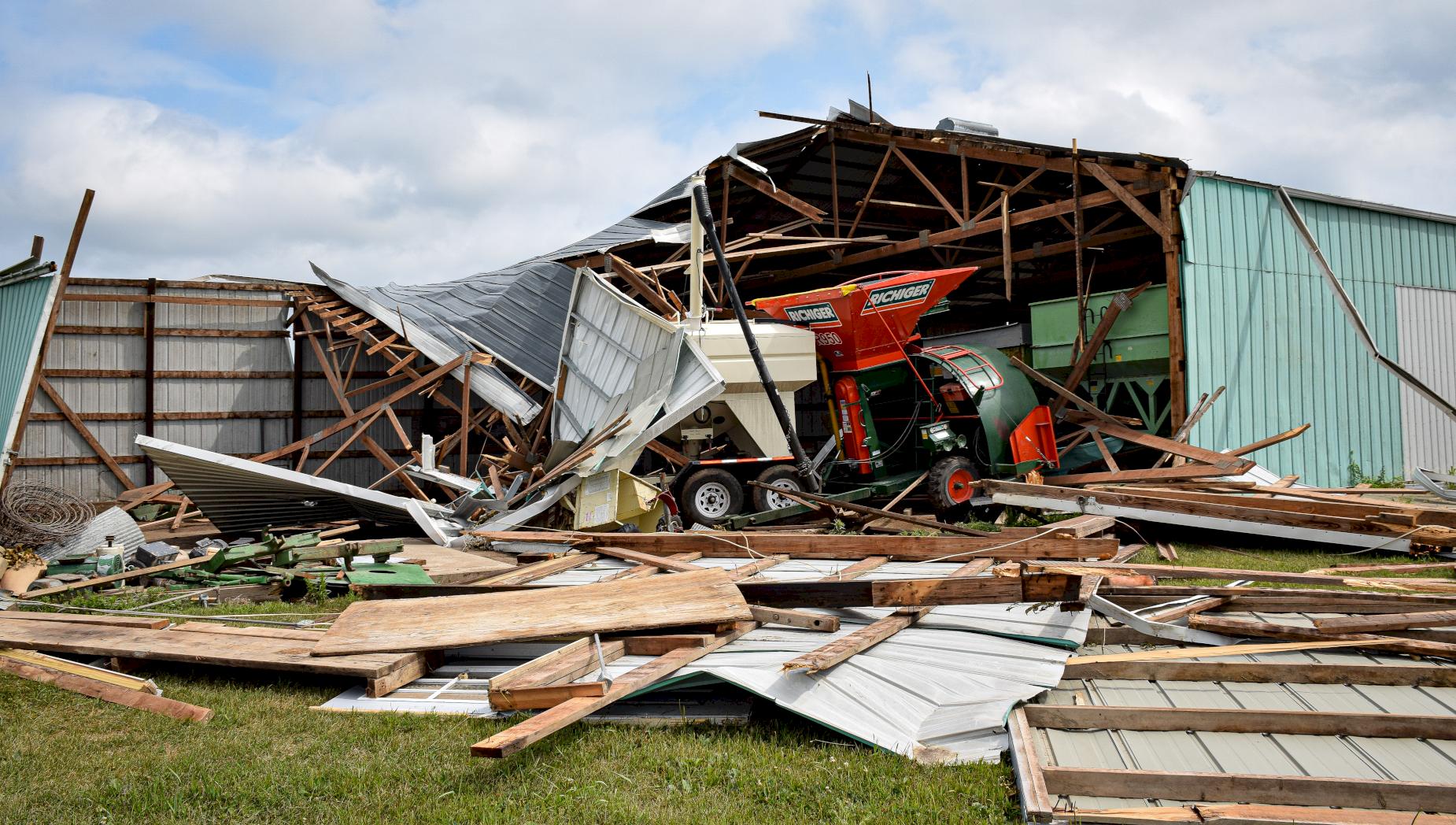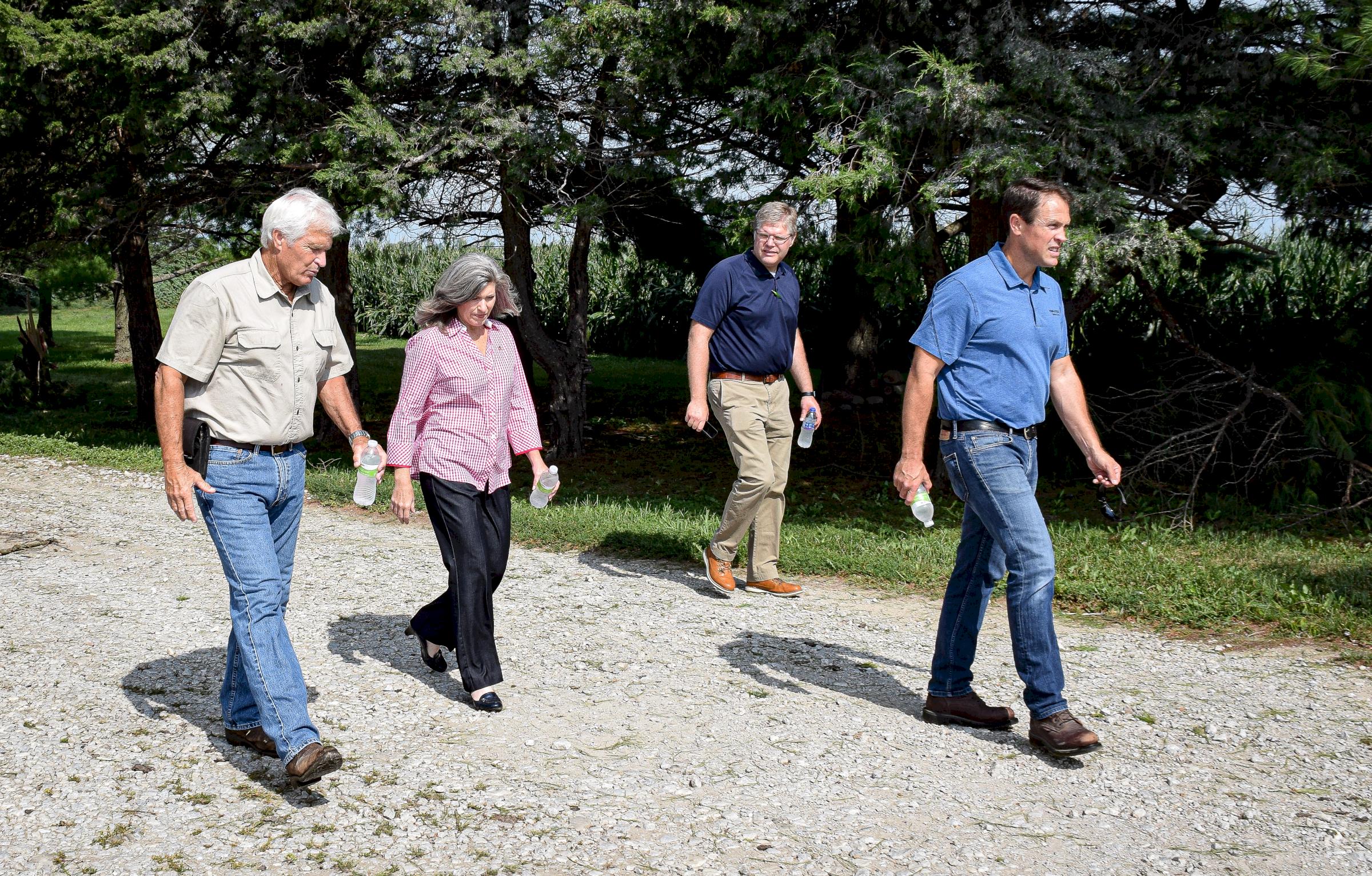
A machine shed belonging to the Kimberley family suffered extensive damage after the derecho hit central Iowa on Aug. 10. (Photo: Bethany Baratta/Iowa Soybean Association)
Straight-line winds in excess of 90 miles per hour in some areas knocked over corn, tangled up soybeans, and wreaked havoc on machine sheds, barns and anything left standing in the path of the storm.
The Aug. 10 storm, classified as a derecho or a line of intense, widespread, and fast-moving windstorms and sometimes thunderstorms, affected an estimated 10 million acres in Iowa, according to Iowa Secretary Mike Naig.
For Grant Kimberley and his father, Rick, the storm dimmed hopes of what was a promising crop year.
“We were set up for 250-bushel-per acre corn,” Grant told Sen. Joni Ernst during a visit Aug. 12 to see the extent of the damage. “And now it’s going to be a super long and hard harvest with nowhere near 250.”
The derecho spread 770 miles in 14 hours, moving west to east from southern South Dakota to western Ohio, according to state climatologist Justin Glisan. The strongest winds were between the Highway 30 and Interstate 80 corridor (including, but not limited to the Des Moines metro, Ames, Newton, Marshalltown, Tama/Toledo, Carroll) from central Iowa eastward into east-central Iowa and northern Illinois, according to the National Weather Service.

Senator Joni Ernst visited the Kimberley farm near Maxwell to assess the damage on Aug. 12. (Photo: Bethany Baratta/Iowa Soybean Association)
On the Kimberley farm just outside of Maxwell, the derecho left no fields untouched.
“We won’t really know the extent of the damage until we get in the fields to harvest,” Rick said.
The family has already called a company in Texas for a Roll-A-Cone attachment for their corn head to help feed downed corn this harvest.
The soybean crop has bounced back a bit in recent days but will likely yield less than a typical year.
“I’ve never seen beans so flat,” says Grant, market development director for the ISA. “They’re still a tangled mess, which might make them more prone to shatter loss if they make it to harvest.”
The Kimberley family experienced loss due to a derecho in 2011. But the force of this storm—the uprooted evergreen trees, smashed machine shed, dismantled grain legs, and damaged grain bins—was unprecedented.
“I thought that was a once-in-a-lifetime event,” Rick told Ernst.
Iowa Soybean Association (ISA) District 5 director Tom Vincent’s farm was in the path of the storm in Perry.
“We’re seeing lots and lots of damage to our fields and in fields nearby,” Vincent said.
Vincent’s crops were already stressed by the D3 drought in central Iowa. Therefore, crops were more susceptible to wind damage.
“The ground was hard and dry, and corn stalks just broke off,” Vincent said.
In some areas, soybeans were broken off.
“Beans usually can take a fair amount of wind, but beans were broken off and laying on the ground,” he said.
Soybeans in his fields were in the middle of pod fill; some plants will likely abort pods, giving up yield potential.
With harvest expected to start within the next 6 to 8 weeks in the state, Vincent said there are more questions than answers about the potential crop. Flattened corn is susceptible to dirt and mold, which impacts grain quality. Will a harvest—albeit slow—be possible with flattened crops?
What about grain storage?
Based on conversations and visits to cooperatives in the state, Naig estimates that tens of millions of commercial grain storage and on-farm grain storage has been destroyed or severely impacted.
“There will be a significant effort to repair and put more storage online before the fall, but it’s hard to imagine significant storage will be able to be rebuilt before fall this year,” Naig said.
He said commercial grain handling facilities are discussing the scope of the damage, potentially adding temporary outside storage to make up for lost physical storage.
The derecho also brought along some hail in ISA District 4 Director Jeff Frank’s area near Auburn. Golf ball-sized hail hit about 20% of one of Frank’s corn fields; soybean fields nearby also sustained some damage, though not as severe. Farmers with soybean fields just another mile south of that farm were wiped out due to the hail.
Frank’s fields were west of the heaviest-hit areas of the state. State climatologist Glisan said Le Grand, Iowa, near Tama, reported winds up to 106 miles per hour.
Farmers also sustained damage to barns and livestock facilities.
Strong winds blew out both ends of ISA District 5 Director Morey Hill’s barn near Madrid. Trees were uprooted, shingles were missing from the family’s home and crops were heavily impacted.
“It looks like somebody just took a roller to the corn,” Hill said. “There’s nothing standing.”
Soybeans were beaten down and tangled up, but Hill says soybeans look like they may come back a bit.
ISA farmer member Dave Struthers was working to get hogs fed and clearing tree limbs after losing hoop barns and electricity in the storm. Struthers says more than 800 hogs were displaced; the family was finding additional sites to house hogs before finding a more permanent solution. Crops also sustained damage, with some acres of snapped corn.
A path forward
Under the storm-ravaged machine shed on Kimberley’s farm, is the bagging machine, which will be used for grain storage this year after the derecho severely damaged two grain bins, knocking 140,000 bushels of storage useless.
Like so many across the state, the family is awaiting a visit from their insurance agent to survey the damage and begin rebuilding.
“We’re all just here kind of dumbfounded,” Rick said. “There’s just nothing you can do.”
Contact Bethany Baratta at bbaratta@iasoybeans.com.